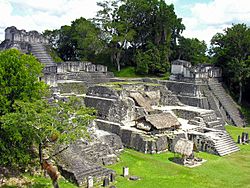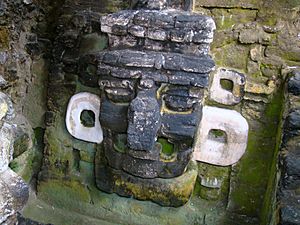Tikal Temple 33 facts for kids

Only the base of Temple 33 now survives, here occupying the centre of the photo
|
|
| Location | Flores |
|---|---|
| Region | Petén Department, Guatemala |
| History | |
| Founded | AD 457 |
| Periods | Early Classic |
| Cultures | Maya civilization |
| Site notes | |
| Excavation dates | 1965 |
| Archaeologists | William R. Coe |
| Architecture | |
| Architectural styles | Early Classic Maya |
| Architectural details | Number of monuments: 2 Number of temples: 1 |
| Responsible body: IDAEH | |
Tikal Temple 33 (also known as 5D-33) was a tall ancient Maya pyramid. It stood about 33 meters (108 feet) high. This important building was located in the North Acropolis of the great Maya city of Tikal.
The pyramid was a special burial place for a king. It was built right over the tomb of King Siyaj Chan K'awiil II. This tomb was sealed in the year AD 457. Temple 33 was built in three main stages over time. Archaeologists have studied this temple more than almost any other Maya temple.
Contents
Building the Temple: A History
Temple 33 was built as a monument for Siyaj Chan K'awiil II. He was a king of Tikal in the 5th century. The pyramid was built directly over his tomb, which was dug into the rock below.
The temple was built in three different stages over about 200 years. Archaeologists named these stages 33-1 (the final version), 33-2 (the middle version), and 33-3 (the first, original shrine).
The first version (33-3) was a low platform built as a shrine for the king's burial. It had large stucco masks, over 3 meters (10 feet) tall, on each side of the stairs.
The second version (33-2) was built soon after the first. A new structure was added on top of the platform. More stucco masks and panels were also added. The walls inside this shrine had ancient drawings and writings, called graffiti. Some were carved into soot, and others into the plaster underneath.
The third and final version (33-1) was built later, during a time known as the Tikal Hiatus (AD 562 to 692). During this time, a large stone monument called Stela 31 was moved. It was placed inside the second version of the temple, right above the king's original tomb. This was done in a special ceremony with fire and broken pottery.
A new, taller pyramid was then built over everything, reaching 33 meters (108 feet) high. This new pyramid was meant to hold another royal burial, but the person buried there is not known. Another important person was also buried inside the pyramid's core. When archaeologists dug up Temple 33-1 in the late 1950s, they found its outer walls were very damaged by time and plants.
Why Temple 33 Was Taken Apart
Temple 33-1, the final version, was completely taken apart by archaeologists in 1965. They did this to reach and study the older parts of the temple underneath. The archaeologists decided they did not have enough money or people to fix the damaged pyramid.
They also needed material to fill a large ditch they had dug in the North Acropolis. The stones from Temple 33-1 were enough to fill it. This was a big reason for their decision to take the pyramid apart. The Guatemalan Instituto de Antropología e Historia (IDAEH) approved this in 1964.
This decision was quite debated. Another archaeologist, Heinrich Berlin, criticized it in 1967. He asked why the pyramid was uncovered if there were no plans to restore it. He also pointed out that other damaged pyramids had been fully restored. Berlin felt it was wrong to destroy a pyramid for fill material when other fill was available.
The archaeologists who took the temple apart defended their choice. They said they learned a lot from taking it apart. They learned about how Maya pyramids were built and about the history of Tikal. Another expert, J. Eric Thompson, said that even if it was a wrong decision, "the loss to mankind is not too serious."
Important Stone Monuments
Stela 31 was a large stone monument buried above King Siyaj Chan K'awiil II's tomb. This happened during the third building phase. The stela was broken before it was moved to its new spot.
Stela 31 was made in AD 445. It shows King Siyaj Chan K'awiil II with his royal symbols. His father, Yax Nuun Ayiin I, is shown three times on the monument. The stela was carved in an old style, like Stela 29, which was made much earlier.
The stela shows strong influence from another ancient city, Teotihuacan. King Siyaj Chan K'awiil II wears a Teotihuacan symbol. His father, Yax Nuun Ayiin, is shown as a Teotihuacan warrior on both sides of the monument. He also appears above his son on the front, shown in the Maya style as an ancient sun god.
The back of the stela has a long text in hieroglyphs. This text explains King Siyaj Chan K'awiil's right to rule. It mentions his mother's family and the start of a new royal family linked to Teotihuacan. It also briefly talks about the king becoming ruler, an important date in 435, when the monument was made, and the death of his grandfather in 439.
Altar 19 was a stone altar found buried in the final version of Temple 33. It was right in front of the second version of the shrine. The altar was badly damaged and broken into three pieces. Most of a carved image of a seated person was chipped away.
The pieces were buried together, near Stela 31. This might mean they were displayed together in public long ago. The altar was made of limestone and is now in the Tikal museum. It is thought to be from around AD 445.
Burials Inside Temple 33
Archaeologists found three burials inside Temple 33:
Burial 23 was a royal tomb. It was placed by removing part of the second phase stairway. The person in this tomb is not known for sure. It might be the burial place of King Nuun Ujol Chaak, who lived in the late 7th century.
The tomb was dug into the rock under the temple, south of King Siyaj Chan K'awiil II's tomb. The king seems to have been buried quickly. Plaster from the walls was found on some of the items in the tomb. A worker even left a flint tool behind by accident. The king's body was placed on a special bed covered with cinnabar (a red mineral) and jaguar-pelts. The body was then covered with layers of seashells.
Burial 24 was the burial of an important person. It was placed inside the pyramid's rubble core during the third building phase.
Burial 48 was the tomb of King Siyaj Chan K'awiil II. It was carved from the bedrock. This tomb was in the very center of the North Acropolis. Two other people were also buried with the king.
The walls of the rock tomb were painted with hieroglyphs. These writings describe the chamber as a divine underworld. They also give a completion date of March 457, one year after the king died. The king's remains were bundled and placed in a sitting position. His skull, hands, and thigh bones were missing.
The two other people buried with him were a child and a teenager. They were placed on opposite sides of the chamber, next to the king. Their positions suggest they were placed in the tomb after they died.
The tomb also contained 27 ceramic pots. Some of these pots were made locally, while others were imported from far away. One special pot was not Maya. It was a black cylinder pot decorated in the style of Teotihuacan. Even though the pot was from Teotihuacan, its lid was a mix of Teotihuacan and Maya styles. It was likely made in Tikal to fit the foreign pot.
Other items found included stone and shell objects. There was a well-used stone metate (a grinding stone) and its handstone. Many jade objects were also found. These included jade discs, hundreds of beads that formed a necklace, and two pairs of earspools. Two obsidian blades were also with the burial.
The tomb was reached through a tunnel dug horizontally. This tunnel had stairs leading down from the lowest part of the North Acropolis. The walls of the tunnel were covered with stucco, and the hieroglyphs were painted on them like frescos. Once the king was buried, the tunnel was sealed with limestone blocks. The tunnel was about 7 meters (23 feet) below the terrace. The tomb chamber itself was about 9 meters (30 feet) long (north to south) and 5 meters (16 feet) wide (east to west). It was shaped like a rounded rectangle.
Images for kids
See also
 In Spanish: Templo 33 para niños
In Spanish: Templo 33 para niños






